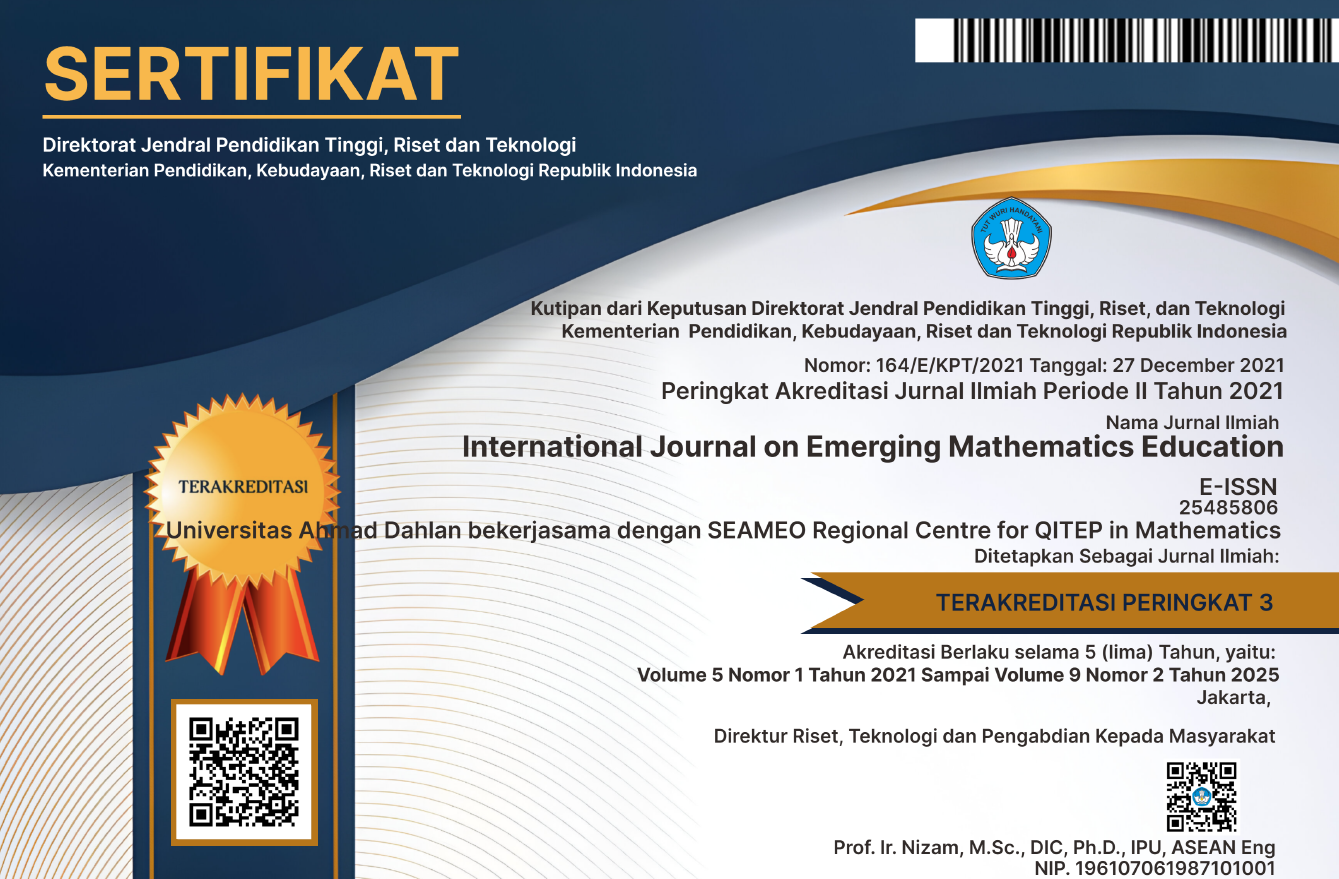Analysis of Student Errors in Learning Circle Based on the Watson Error Category
DOI:
https://doi.org/10.12928/ijeme.v4i1.15840Keywords:
Error Analysis, Watson Error Category, CircleAbstract
Error analysis is a process of reviewing students' answers to identify patterns of understanding. Errors in mathematics are considered as deviations from the actual solution of a problem. The aim of the study is to analyze student errors based on the Watson error category learning circle. In this study students were given 5 essay mathematical problems, and then analyzed their errors based on 8 Watson error categories and continued by interviewing 1 student for each category of error. This study was conducted at SMP PGRI 3 Denpasar in a class on IX grade with 40 students. The results show that the percentage of student errors categories obtained from this study as follows: comprehension errors 54%, transformation errors 18%, process skills errors 15%, encoding errors 7%. Students are interviewed to find out carelessness and motivation that affect students' mistakes. While for question form category we found no errors.
ÂReferences
Chrisnawati, U. N. (2012). Analisis Kesalahan Siswa Kelas VIIII SMP dalam Menyelesaikan Soal Pokok Bahasa Lingkaran dengan Panduan Kriteria Watson. Skripsi. Surakarta: Universitas Muhammadiyah Surakarta.
Egodawatte, Gunawardena. (2009). Is algebra really difficult for all students?. Acta Didactica Napocensia, 2(4). 102-106.
Fong, Ho-Kheong. 1993. Schematic Model for Categorizing Children's Errors In Mathematics. Third International Seminar on Misconceptions and Educational Strategies in Science and Mathematics, Ithaca, 1-28.
Gökhan, Özsoy. (2015). Evaluation of Students’ Mathematical Problem-Solving Skills in Relation to Their Reading Levels. International Electronic Journal of Elementary Education, 2015, 8(1), 113-132.
Hendroanto, A., Istiandaru, A., Syakrina, N., Setyawan, F., Prahmana, R. C. I., & Hidayat, A. S. E. (2018). How Students Solves PISA Tasks: An Overview of Students’ Mathematical Literacy. International Journal on Emerging Mathematics Education, 2(2), 129-138.
Lai, Cheng-Fei. (2012). Error Analysis in Mathematics. Behavioral Research and Teaching. Thesis. Eugene: University of Oregon.
LI, X. (2006). Cognitive Analysis of Students’ Errors And Misconceptions In Variables, Equations, And Functions. Texas: A&M University.
Legutko, M. (2008). An analysis of students’ mathematical errors in the teachingresearch process. Handbook for mathematics teaching: Teacher experiment. A tool for research, 141-152.
M.A. (“Kenâ€), C., & Nerida, E. (1996). Newman Error Analysis Research, and Implications for the Issue of “What is Basic?†In Mathematics Education Research: Past, Present and Future. Thailand: UNESCO Principal Regional Office for Asia and the Pacific.
OECD Publishing. (2011). Education at a glance 2011: OECD Indicators. Organisation for Economic Co-operation and Development.
Radatz, Hendrik. 1980. Students' Errors in the Mathematical Learning Process: a Survey. For the Learning of Mathematics, 1(1), 16-20
Rohmah, Mushlihah. (2017). Analysis Problem Solving in Mathematical Using Theory Newman. EURASIA Journal of Mathematics, Science and Technology Education. 1 – 11.
Sugiyono. (2008). Metode Penelitian Pendidikan. Bandung: Alfabeta.
Susilawati, & Febrian. (2016). Analisis Kesalahan Siswa Kelas X MIA 3 SMA Negeri 1 Tanjungpinang Tahun Pelajaran 2015/2016 dalam Menyelesaikan Permasalahan Peluang Dengan Menggunakan Kategori Kesalahan Watson.
Wiens. (2007). An Investigation into Careless Errors Made by 7th Grade Mathematics Students. Lincoln: University of Nebraska.
Downloads
Published
How to Cite
Issue
Section
License
License and Copyright Agreement
In submitting the manuscript to the journal, the authors certify that:
- They are authorized by their co-authors to enter into these arrangements.
- The work described has not been formally published before, except in the form of an abstract or as part of a published lecture, review, thesis, or overlay journal. Please also carefully read the International Journal on Emerging Mathematics Education (IJEME) Author Guidelines at http://journal.uad.ac.id/index.php/IJEME/about/submissions#authorGuidelines
- That it is not under consideration for publication elsewhere,
- That its publication has been approved by all the author(s) and by the responsible authorities, tacitly or explicitly, of the institutes where the work has been carried out.
- They secure the right to reproduce any material that has already been published or copyrighted elsewhere.
- They agree to the following license and copyright agreement.
Copyright
Authors who publish with the International Journal on Emerging Mathematics Education (IJEME) agree to the following terms:
- Authors retain copyright and grant the journal the right of first publication with the work simultaneously licensed under a Creative Commons Attribution License (CC BY-SA 4.0) that allows others to share the work with an acknowledgment of the work's authorship and initial publication in this journal.
- Authors are able to enter into separate, additional contractual arrangements for the non-exclusive distribution of the journal's published version of the work (e.g., post it to an institutional repository or publish it in a book), with an acknowledgment of its initial publication in this journal.
- Authors are permitted and encouraged to post their work online (e.g., in institutional repositories or on their website) prior to and during the submission process, as it can lead to productive exchanges, as well as earlier and greater citation of published work.
![]()
Ciptaan disebarluaskan di bawah Lisensi Creative Commons Atribusi-BerbagiSerupa 4.0 Internasional.




